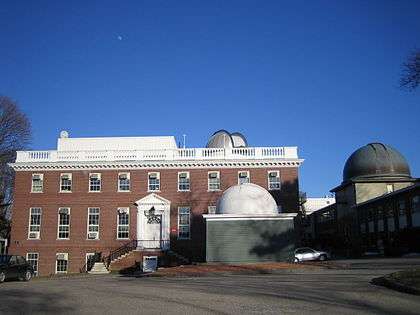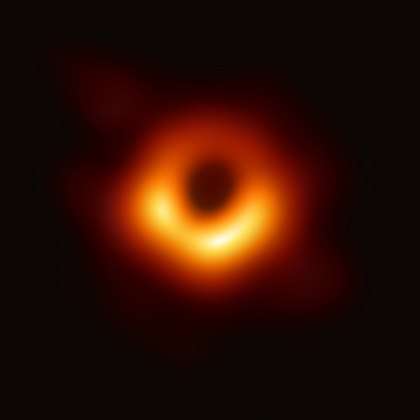Smithsonian Astrophysical Observatory
The Smithsonian Astrophysical Observatory (SAO) is a research institute of the Smithsonian Institution, concentrating on astrophysical studies including galactic and extragalactic astronomy, cosmology, solar, earth and planetary sciences, theory and instrumentation, using observations at wavelengths from the highest energy gamma rays to the radio, along with gravitational waves. Established in Washington, D.C., in 1890, the SAO moved its headquarters in 1955 to Cambridge, Massachusetts, where its research is a collaboration with the Harvard College Observatory (HCO) and the Harvard University Department of Astronomy. In 1973, the Smithsonian and Harvard formalized the collaboration as the Center for Astrophysics | Harvard & Smithsonian (CfA) under a single Director.
 The Center for Astrophysics | Harvard & Smithsonian (CfA) Headquarters in Cambridge, Massachusetts. The Smithsonian Astrophysical Observatory (SAO) has been joined with the CfA since 1973. | |
| Abbreviation | SAO |
|---|---|
| Established | 1890 |
| Purpose | Research in astronomy, astrophysics, Earth, and space sciences |
| Headquarters | 60 Garden Street, Cambridge, Massachusetts, United States |
Director | Charles R. Alcock |
Staff | 850+ |
| Website | www |
History

Samuel Pierpont Langley, the third Secretary of the Smithsonian, founded the Smithsonian Astrophysical Observatory on the south yard of the Smithsonian Castle (on the U.S. National Mall) on March 1,1890. The Astrophysical Observatory's initial, primary purpose was to "record the amount and character of the Sun's heat[1]". Charles Greeley Abbot was named SAO's first director, and the observatory operated solar telescopes to take daily measurements of the Sun's intensity in different regions of the optical electromagnetic spectrum. In doing so, the observatory enabled Abbot to make critical refinements to the Solar constant, as well as to serendipitously discover Solar variability. It is likely that SAO's early history as a solar observatory was part of the inspiration behind the Smithsonian's "sunburst" logo, designed in 1965 by Crimilda Pontes.[2]
In 1955, the scientific headquarters of SAO moved from Washington, D.C. to Cambridge, Massachusetts to affiliate with the Harvard College Observatory (HCO).[1] Fred Lawrence Whipple, then the chairman of the Harvard Astronomy Department, was named the new director of SAO. The collaborative relationship between SAO and HCO therefore predates the official creation of the CfA by 18 years. SAO's move to Harvard's campus also resulted in a rapid expansion of its research program. Following the launch of Sputnik (the world's first human-made satellite) in 1957, SAO accepted a national challenge[3] to create a worldwide satellite-tracking network, collaborating with the United States Air Force on Project Space Track.
With the creation of NASA the following year and throughout the space race, SAO led major efforts in the development of orbiting observatories and large ground-based telescopes, laboratory and theoretical astrophysics, as well as the application of computers to astrophysical problems.
| SAO Director | Years as Director |
|---|---|
| Samuel Pierpont Langley | 1890–1906 |
| Charles Greeley Abbot | 1906-1942 |
| Loyal Blaine Aldrich | 1942-1955 |
| Fred Lawrence Whipple | 1955-1973 |
| George B. Field | 1973-1982 |
| Irwin I. Shapiro | 1972-2004 |
| Charles R. Alcock | 2004-present |
Remote stations
SAO has operated a number of remote stations over the years.[4][5]
| Station | Type | Latitude | Longitude | El. (m) | Opened | Closed | Coordinates |
|---|---|---|---|---|---|---|---|
| Mount Wilson, California | Solar | 34º13'N | 118º56'W | 1737 | 1908 | 1920 | 34°13′N 118°56′W |
| Hump Mountain, North Carolina | Solar | 36º8'N | 82º0'W | 1500 | 1917 | 1918 | 36°8′N 82°0′W |
| Calama, Chile | Solar | 22º28'S | 68º56'W | 2250 | 1918 | 1920 | 22°28′S 68°56′W |
| Mount Montezuma, Chile | Solar | 22º40'S | 68º56'W | 2711 | 1920 | ? | 22°40′S 68°56′W |
| Mount Harquahala, Arizona | Solar | 33º48'N | 113º20'W | 1721 | 1920 | 1925 | 33°48′N 113°20′W |
| Table Mountain, California | Solar | 34º22'N | 117º41'W | 2286 | 1925 | 1962 | 34°22′N 117°41′W |
| Mount Brukkaros, Namibia | Solar | 25º52'S | 17º48'E | 1586 | 1926 | 1931 | 25°52′S 17°48′E |
| Mount Saint Catherine, Egypt | Solar | 28º31'N | 33º56'E | 2591 | 1934 | 1937 | 28°31′N 33°56′E |
| Burro Mountain, New Mexico | Solar | 32º40'N | 108º33'W | 2440 | 1938 | 1946 | 32°40′N 108°33′W |
| Organ Pass, New Mexico | Space Track | 32º25'N | 253º27'E | 32°25′N 106°33′W | |||
| Olifantsfontein, South Africa | Space Track | 25º58'S | 28º15'E | 25°58′S 28°15′E | |||
| Woomera, Australia | Space Track | 31º06'S | 136º46'E | 31°06′S 136°46′E | |||
| Cadiz, Spain | Space Track | 36º28'N | 353º48'E | 36°28′N 6°12′W | |||
| Shiraz, Iran | Space Track | 29º38'N | 52º31'E | 29°38′N 52°31′E | |||
| Curaçao, Netherlands West Indies | Space Track | 12º05'N | 291º10'E | 12°05′N 68°50′W | |||
| Jupiter, Florida | Space Track | 27º01'N | 279º53'E | 27°01′N 80°07′W | |||
| Haleakala, Hawaii | Space Track | 20º43'N | 203º45'E | 20°43′N 156°15′W | |||
| Villa Dolores, Argentina | Space Track | 31º57'S | 294º54'E | 31°57′S 65°06′W | |||
| Mitaka, Japan | Space Track | ||||||
| Nani Tal, India | Space Track | ||||||
| Arequipa, Peru | Solar, Space Track |
||||||
| Oak Ridge Observatory |
SAO Today
The current director of the SAO is Charles R. Alcock (2004 to present). There are currently about 170 research staff working at the SAO, including affiliated research staff. In addition, the SAO has about 120 postdoctoral researchers/fellows working in five competitive, associated fellowship programs: CfA, Clay, SMA, ITAMP, and Leon Van Speybroeck, or in support of a contract or grant. (Additional postdocs do research via Harvard fellowship programs or national/international fellowship awards); about 40% of the postdoctoral community are women and about 12% are from minority populations. SAO scientists can supervise Harvard Ph.D students, and in addition they typically supervise about 30 graduate students from other institutions who are pursuing Ph.D. theses at the SAO. About thirty undergraduate students intern at the SAO each year. All together there are about 950 staff (including administrative and management department employees) working at the Center.

Directors
- Samuel Pierpont Langley 1890–1906[7]
- Charles Greeley Abbot 1906–1942[7]
- Loyal Blaine Aldrich 1942–1955[7]
- Fred Lawrence Whipple 1955–1973[7]
- George B. Field 1973–1982[7] (with the creation of the Harvard-Smithsonian Center for Astrophysics in 1973, the director of SAO and the Harvard College Observatory became a joint position)
- Irwin I. Shapiro 1982–2004[7]
- Charles R. Alcock 2004–[8]
References
- DeVorkin, David H. (2018). Fred Whipple's Empire: The Smithsonian Astrophysical Observatory, 1955-1973. Smithsonian Institution Scholarly Press.
- Anonymous (2020-03-24). "Crimilda Pontes: The Original Designer of the Smithsonian Sunburst". Smithsonian Institution Archives. Retrieved 2020-04-29.
- Spiller, James (2015). "Rising to the Sputnik Challenge". In Spiller, James (ed.). Frontiers for the American Century. Frontiers for the American Century: Outer Space, Antarctica, and Cold War Nationalism. Palgrave Studies in the History of Science and Technology. Palgrave Macmillan US. pp. 21–64. doi:10.1057/9781137507877_2. ISBN 978-1-137-50787-7.
- Wright, F. W.; Hodge, P. W. (1965). "The Volcanic Dust Sampling Program of the Smithsonian Astrophysical Observing Stations". SAO Special Report #172 (1965). 172: 172. Bibcode:1965SAOSR.172.....W.
- Roosen, Robert G.; Angione, Ronald J. (1977). "Variations in Atmospheric Water Vapor: Baseline Results from Smithsonian Observations". Publications of the Astronomical Society of the Pacific. 89: 814. Bibcode:1977PASP...89..814R. doi:10.1086/130233.
- "CfA Plays Central Role In Capturing Landmark Black Hole Image". www.cfa.harvard.edu/. 2019-04-09. Retrieved 2020-04-27.
- "SAO Directors: 1834 - Present". Smithsonian Astrophysical Observatory. Retrieved 2015-09-03.
- "Charles Alcock Named Director of the Harvard-Smithsonian Center for Astrophysics". Harvard-Smithsonian Center for Astrophysics. Retrieved 2015-09-17.